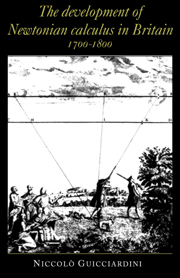Book contents
- Frontmatter
- Contents
- Introduction
- OVERTURE: NEWTON'S PUBLISHED WORK ON THE CALCULUS OF FLUXIONS
- PART I THE EARLY PERIOD
- PART II THE MIDDLE PERIOD
- PART III THE REFORM
- 7 SCOTLAND (1785–1809)
- 8 THE MILITARY SCHOOLS (1773–1819)
- 9 CAMBRIDGE AND DUBLIN (1790–1820)
- CONCLUSION
- APPENDIX A TABLES OF CONTENTS OF FLUXIONARY TEXTBOOKS
- APPENDIX B PRICE LIST OF MATHEMATICAL BOOKS PRINTED FOR JOHN NOURSE
- APPENDIX C CHAIRS IN THE UNIVERSITIES
- APPENDIX D MILITARY ACADEMIES
- APPENDIX E SUBJECT INDEX OF PRIMARY LITERATURE
- APPENDIX F MANUSCRIPT SOURCES
- Notes
- Bibliography
- Index
9 - CAMBRIDGE AND DUBLIN (1790–1820)
from PART III - THE REFORM
Published online by Cambridge University Press: 14 September 2009
- Frontmatter
- Contents
- Introduction
- OVERTURE: NEWTON'S PUBLISHED WORK ON THE CALCULUS OF FLUXIONS
- PART I THE EARLY PERIOD
- PART II THE MIDDLE PERIOD
- PART III THE REFORM
- 7 SCOTLAND (1785–1809)
- 8 THE MILITARY SCHOOLS (1773–1819)
- 9 CAMBRIDGE AND DUBLIN (1790–1820)
- CONCLUSION
- APPENDIX A TABLES OF CONTENTS OF FLUXIONARY TEXTBOOKS
- APPENDIX B PRICE LIST OF MATHEMATICAL BOOKS PRINTED FOR JOHN NOURSE
- APPENDIX C CHAIRS IN THE UNIVERSITIES
- APPENDIX D MILITARY ACADEMIES
- APPENDIX E SUBJECT INDEX OF PRIMARY LITERATURE
- APPENDIX F MANUSCRIPT SOURCES
- Notes
- Bibliography
- Index
Summary
in this final chapter we will consider the important contributions to the reform of the calculus which took place in Cambridge and Dublin. There is a link between the two universities, since John Brinkley, one of the most influential Dublin reformers, was educated at Cambridge and brought the heritage of Maskelyne and Waring to Ireland. Furthermore, both the Dublin and the Cambridge reformers were deeply concerned with the teaching of mathematics. Their attempt to reform the teaching of mathematics (and the calculus in particular) was much bolder than that of Playfair in Edinburgh, while – as we have seen – in the military schools such a project could not be implemented. The Dublin group insisted more on the teaching of applied mathematics (mechanics, physical astronomy, optics, etc.), whereas the Cambridge group was definitely purist–algebraist. A distinction must also be made at the level of research: in Ireland the stimulus came from Laplace, while in Cambridge the reformers were followers of Lagrange. Scholars of William Rowan Hamilton's optics, quaternions and mechanics, as well as scholars of the algebras of Peacock, Boole and De Morgan, will find this distinction quite significant.
Fluxions in Cambridge
During the late eighteenth century, Cambridge did not appear a promising centre of mathematical reform. Notwithstanding the fact that mathematics had become the most important subject in the education and in the ranking of students, their curriculum did not include any of the advances made after the 1720s.
- Type
- Chapter
- Information
- The Development of Newtonian Calculus in Britain, 1700–1800 , pp. 124 - 138Publisher: Cambridge University PressPrint publication year: 1989



